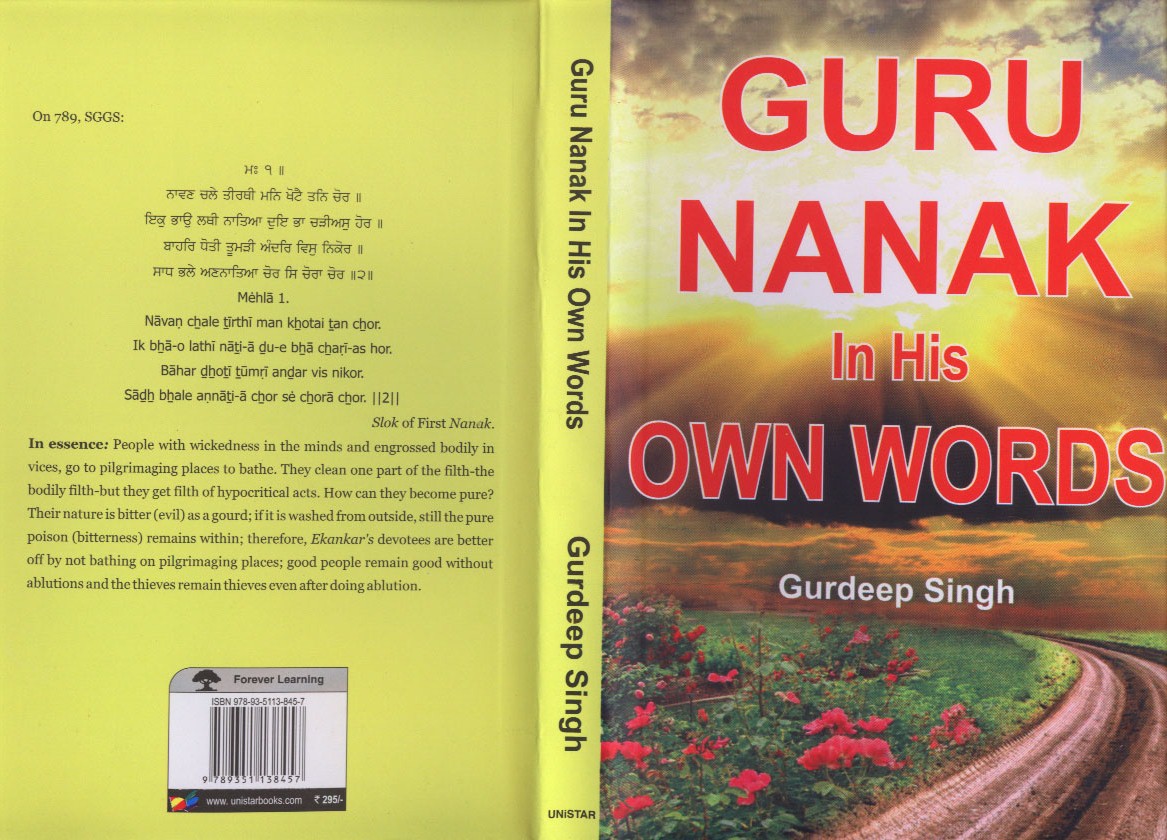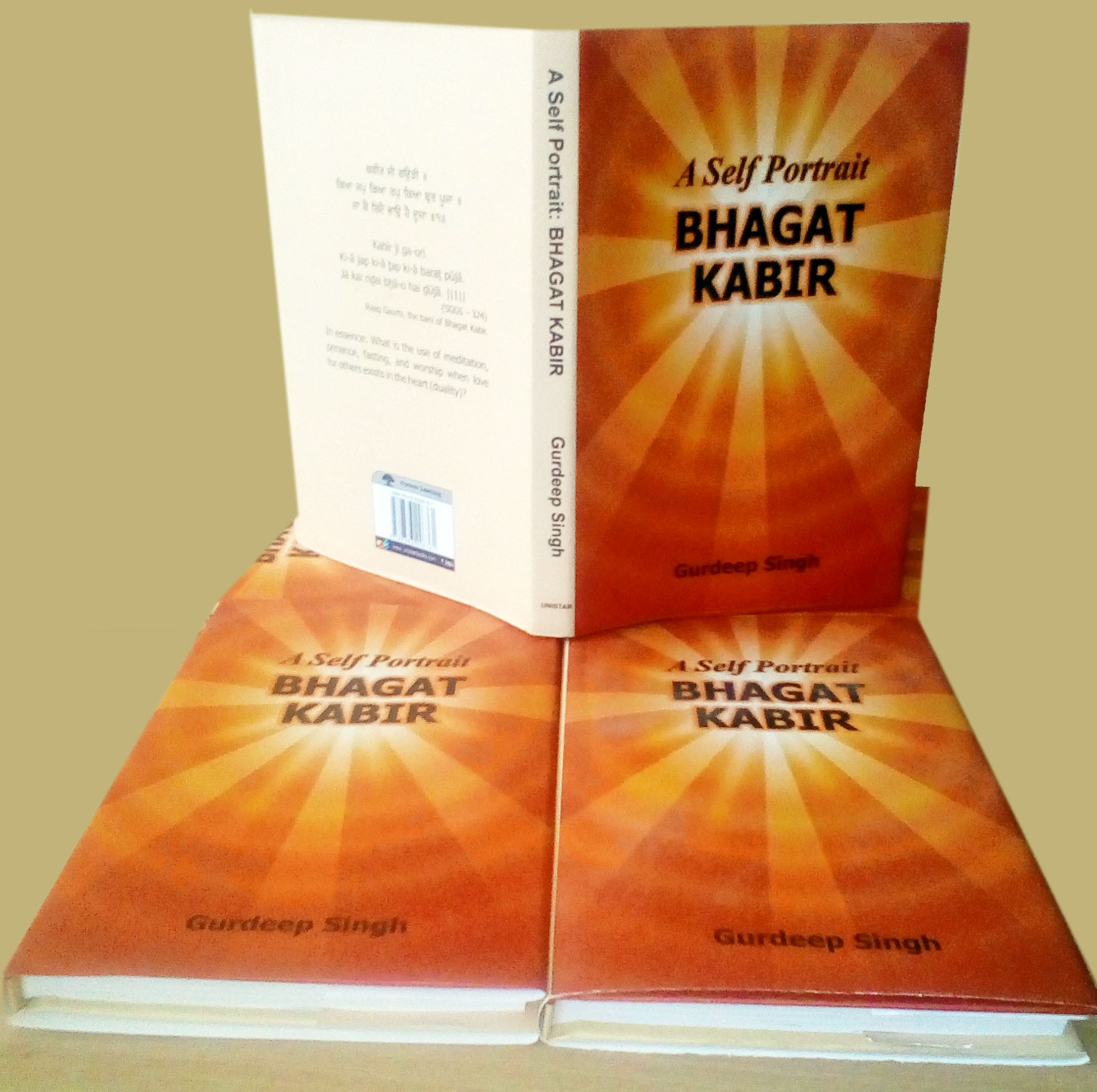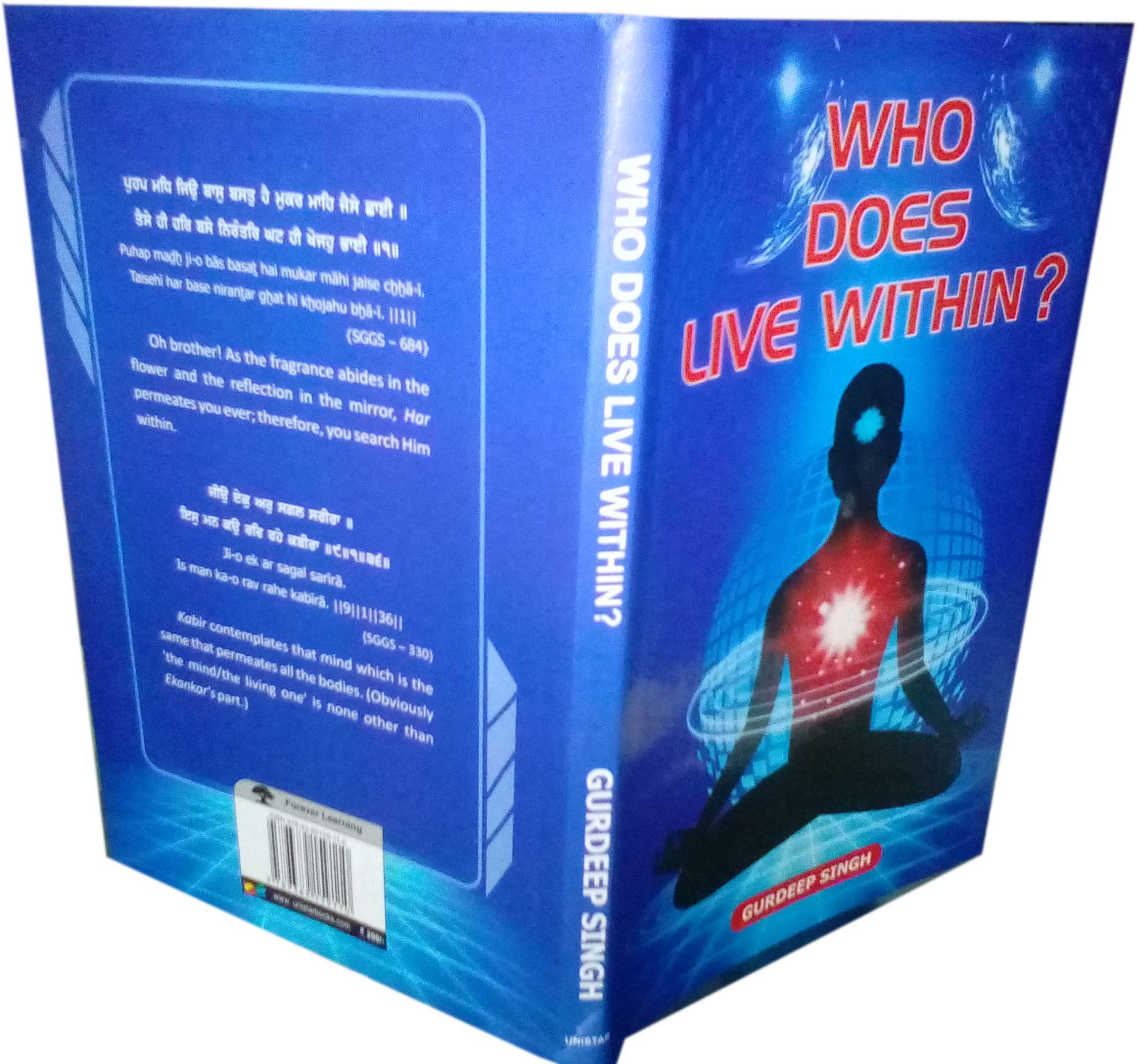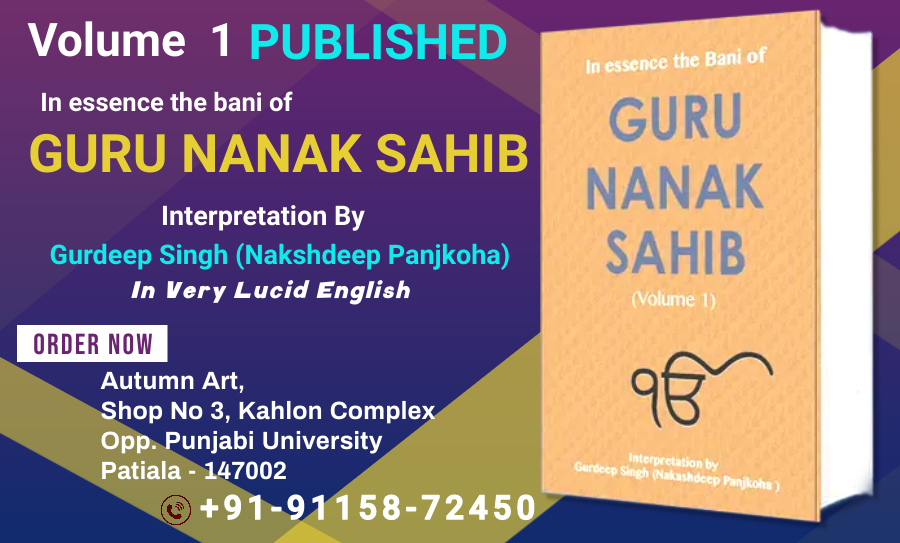Now it has become clear that our Creator, as per Guru Nanak, is a permeating entity with infinite power and well above the human like entity governed by human feelings and thoughts, because unlike the human, He is infinite, beyond birth or death. As He is addressed as an active Creator, though formless, He remains present in His creation, seen or unseen. In simple words, seen or unseen things or lives are actually His part, but that prompts us to think about His form. How a formless one can have a form? We know that any form has a limited life span, but that is not the case with our Creator, because He is infinite/Apar. Going back to the words we already addressed: ਕਰਤਾ ਪੁਰਖੁ /karta purakh and ਅਕਾਲ ਮੂਰਤਿ /Akalmurat may help us here.
First let us address again the word, ਕਰਤਾ ਪੁਰਖੁ /Karta Purakh; it means: A Creator who permeates; this identification indicates that the Creator keeps His presence in whatever He creates; He permeates the forms, but it is obvious that a form is bound to be ended sooner or later; nonetheless, the Guru’s another word used for Him, “ਅਕਾਲ ਮੂਰਤਿ /Akalmurat/ His form is beyond death ” explains that the Creator’s created forms may crumble and end up in different forms after their end, but His presence remains in all of them even then including His life or inanimate creation.
Now the concept of His Form that has no end becomes clearer. His infinite presence is not limited to the forms we figure out; therefore, His presence in forms is addressed as His sargun sroop (Him, with attributes); however, His identification as an independent entity is addressed as “Nirgun Sroop (Him, with no attributes: no form, color and so on); therefore, it can be inferred that the Nirgun Creator keeps His presence in His entire creation, which must be deemed as His Sargun Sroop.
Let us take help in this context from Ninth Nanak’s own words about this. On 684, SGGS, Ninth Nanak says:
ਪੁਹਪ ਮਧਿ ਜਿਉ ਬਾਸੁ ਬਸਤੁ ਹੈ ਮੁਕਰ ਮਾਹਿ ਜੈਸੇ ਛਾਈ ॥
ਤੈਸੇ ਹੀ ਹਰਿ ਬਸੇ ਨਿਰੰਤਰਿ ਘਟ ਹੀ ਖੋਜਹੁ ਭਾਈ ॥੧॥
Puhap maḏẖ ji-o bās basaṯ hai mukar māhi jaise cẖẖā-ī.
Ŧaise hī har base niranṯar gẖat hī kẖojahu bẖā-ī. ||1||
In essence: Oh brother! As the fragrance abides in the flower or the reflection in the mirror, Har permeates you ever; therefore, you search Him within.
The lesson is simple that the Creator is present in His entire creation as fragrance abides in the flower or a reflection is seen in a mirror; therefore, our behavior towards His creation should not be hostile. As per the Gurbani, one, who gets over every hostile feeling against anyone or anything, goes close to Him and those who harbor hostility/animosity go far away from Him to realize Him within. What Fifth Nanak says on 671, SGGS verifies it:
ਨਾ ਕੋ ਮੇਰਾ ਦੁਸਮਨੁ ਰਹਿਆ ਨਾ ਹਮ ਕਿਸ ਕੇ ਬੈਰਾਈ ॥
ਬ੍ਰਹਮੁ ਪਸਾਰੁ ਪਸਾਰਿਓ ਭੀਤਰਿ ਸਤਿਗੁਰ ਤੇ ਸੋਝੀ ਪਾਈ ॥੨॥
Nā ko merā ḏusman rahi-ā nā ham kis ke bairā-ī.
Barahm pasār pasāri-o bẖīṯar saṯgur ṯe sojẖī pā-ī. ||2||
In essence: No one is my adversary and I am no one’s enemy. I have understood from the Satiguru that Akalpurakh is expanded in all the lives.
Non-existence of animosity is designed to realize the Creator regardless how difficult appears the loads of negativity we face everyday. Let us now look at First Nanak’s a shabda through which he elaborates what I have written about His “sargun form/His being with attributes; it is on 23, SGGS:
ਸਿਰੀਰਾਗੁ ਮਹਲਾ ੧ ਘਰੁ ਦੂਜਾ ੨ ॥
ਆਪੇ ਰਸੀਆ ਆਪਿ ਰਸੁ ਆਪੇ ਰਾਵਣਹਾਰੁ ॥
ਆਪੇ ਹੋਵੈ ਚੋਲੜਾ ਆਪੇ ਸੇਜ ਭਤਾਰੁ ॥੧॥
Sirīrāg mėhlā 1 gẖar ḏūjā 2.
Āpe rasī-ā āp ras āpe ravaṇhār.
Āpe hovai cẖolṛā āpe sej bẖaṯār. ||1||
Raag Sree Raag, the bani of first Nanak, house second
In essence: The Creator is Himself the enjoyer and the relish. He Himself is the bride, the bridegroom, and their couch.
ਰੰਗਿ ਰਤਾ ਮੇਰਾ ਸਾਹਿਬੁ ਰਵਿ ਰਹਿਆ ਭਰਪੂਰਿ ॥੧॥ ਰਹਾਉ ॥
Rang raṯā merā sāhib rav rahi-ā bẖarpūr. ||1|| rahā-o.
My Master, being filled with love, pervades everywhere. Pause.
ਆਪੇ ਮਾਛੀ ਮਛੁਲੀ ਆਪੇ ਪਾਣੀ ਜਾਲੁ ॥
ਆਪੇ ਜਾਲ ਮਣਕੜਾ ਆਪੇ ਅੰਦਰਿ ਲਾਲੁ ॥੨॥
Āpe mācẖẖī macẖẖulī āpe pāṇī jāl.
Āpe jāl maṇkaṛā āpe anḏar lāl. ||2||
Akalpurakh Himself is the fisherman, the fish, the water, the net, the metal ball of the net, and the bait within.
ਆਪੇ ਬਹੁ ਬਿਧਿ ਰੰਗੁਲਾ ਸਖੀਏ ਮੇਰਾ ਲਾਲੁ ॥
ਨਿਤ ਰਵੈ ਸੋਹਾਗਣੀ ਦੇਖੁ ਹਮਾਰਾ ਹਾਲੁ ॥੩॥
Āpe baho biḏẖ rangulā sakẖī-e merā lāl.
Niṯ ravai sohāgaṇī ḏekẖ hamārā hāl. ||3||
My friend! My beloved plays in many ways. There are those fortunate ones, who have my Master always with them; however, look at my plight! (I don’t have Him).
Note: By pointing at “see my plight”, a hint is given about those persons, who think Him residing somewhere up in the sky and about those who see Him in an idol and feel Him away; it is also about those ones, who fail to realize Him.
ਪ੍ਰਣਵੈ ਨਾਨਕੁ ਬੇਨਤੀ ਤੂ ਸਰਵਰੁ ਤੂ ਹੰਸੁ ॥
ਕਉਲੁ ਤੂ ਹੈ ਕਵੀਆ ਤੂ ਹੈ ਆਪੇ ਵੇਖਿ ਵਿਗਸੁ ॥੪॥੨੫॥
Paraṇvai Nānak benṯī ṯū sarvar ṯū hans.
Ka-ul ṯū hai kavī-ā ṯū hai āpe vekẖ vigas. ||4||25||
Nanak prays humbly: “Oh Master! You are the tank and the swan. You are the lotus. You are the water-lily and you enjoy to behold them”.
Please also note that the fish referred in the shabda above is a living being but the net is not; however, it too comes from Akalpurakh, because all the creation comes from Him. If a man makes it, it still belongs to Him, because all the stuff used for it is a part of Him; besides, the man, who has made it, also comes from Him.
Above in this shabda, Akalpurakh’s presence is expressed in all the lives and lifeless things; literally, everything is a part of Him, alive or not alive as they all emanate from Him, or say that He is Matrix of creativity. It is this harmonious concept, which is necessary to see Him present all around. When we deem Him only as a separate entity from His creation, we simply march towards the complex of duality.
This shabda also elaborates the word ਸੈਭੰ /self illumined used in the mool mantra. There are many shabdas that elaborate the Creator’s “Sargun form”. On 736, SGGS Fifth Nanak elaborates the idea further in details and makes it easier to comprehend this subtle idea about the Creator:
ਜਲ ਤੇ ਊਠਹਿ ਅਨਿਕ ਤਰੰਗਾ ॥ ਕਨਿਕ ਭੂਖਨ ਕੀਨੇ ਬਹੁ ਰੰਗਾ ॥
ਬੀਜੁ ਬੀਜਿ ਦੇਖਿਓ ਬਹੁ ਪਰਕਾਰਾ ॥ ਫਲ ਪਾਕੇ ਤੇ ਏਕੰਕਾਰਾ ॥੨॥
Jal tay ootheh anik tarangaa. Kanik bhookhan keenay baho rangaa.
Beej beej daykhi-o baho parkaaraa. Fal paakay tay aykankaaraa. ||2||
In essence: The waves arise from water; out of gold, many kinds ornaments are made; a seed is sown, and it grows into a tree with branches and fruits along with seeds (waves remain the water, ornaments remain the gold and the seed comes back as a seed through the fruit); from Akalpurakh all emanate, but when all reach to their ends, there remains only Akalpurakh.
ਸਹਸ ਘਟਾ ਮਹਿ ਏਕੁ ਆਕਾਸੁ ॥ ਘਟ ਫੂਟੇ ਤੇ ਓਹੀ ਪ੍ਰਗਾਸੁ ॥
ਭਰਮ ਲੋਭ ਮੋਹ ਮਾਇਆ ਵਿਕਾਰ ॥ ਭ੍ਰਮ ਛੂਟੇ ਤੇ ਏਕੰਕਾਰ ॥੩॥
Sahas ghataa meh ayk aakaas. Ghat footay tay ohee pargaas.
Bharam lobh moh maa-i-aa vikaar. Bharam chhootay tay aikankaar. ||3||
In essence: In thousand water-pots, one sky reflects, but as the water pots are broken, only the sky remains; because of the Maya illusion, the mortals get engrossed in greed, attachment and vices, but when this illusion is gone, they become one with Ekankar.
ਓਹੁ ਅਬਿਨਾਸੀ ਬਿਨਸਤ ਨਾਹੀ ॥ ਨਾ ਕੋ ਆਵੈ ਨਾ ਕੋ ਜਾਹੀ ॥
ਗੁਰਿ ਪੂਰੈ ਹਉਮੈ ਮਲੁ ਧੋਈ ॥ ਕਹੁ ਨਾਨਕ ਮੇਰੀ ਪਰਮ ਗਤਿ ਹੋਈ ॥੪॥੧॥
Oh abhinaasee binsat naahee. Naa ko aavai naa ko jaahee.
Gur poorai ha-umai mal Dho-ee. Kaho naanak mayree param gat ho-ee. ||4||1||
Ekankar is imperishable; therefore, He doesn’t perish; neither one comes, nor one goes (it is all Ekankar’s expansion, which exists and also stops existing). Oh Nanak! The perfect Guru has washed off the filth of my self-conceit; by getting rid of it, I have obtained a complete liberation.
Every day, we see people coming to this world and departing from here; then what is that which doesn’t come or go? The Guru defines that it is Akalpurakh’s light that comes to exist in a live-body and when the body is crumbled, the light doesn’t die. It remains there at it was before that body. It is that light which is addressed as “soul, or inner self or a part of the Creator”. It is important to understand that Ekankar exists in the waves of lights. As a reflection of the sky remains in the pot filled with water, so does Ekankar’s light; as the pot is broken, the sky remains but its reflection disappears; however, it doesn’t mean the sky is gone. This is all about Ekankar’s existence in a form of Jyot (light). Soul/inner self is a part of His Jyot. This tiny light reacts against the main Jyot, Ekankar, as per His Will, but it does so because it resides in a form that is in Maya inflicted environment. When that form is perished, that light part of the main Jyot, still remains. On 1153, First Nanak hints about this scenario on 1153, SGGS:
ਆਤਮ ਮਹਿ ਰਾਮੁ ਰਾਮ ਮਹਿ ਆਤਮੁ ਚੀਨਸਿ ਗੁਰ ਬੀਚਾਰਾ ॥
ਅੰਮ੍ਰਿਤ ਬਾਣੀ ਸਬਦਿ ਪਛਾਣੀ ਦੁਖ ਕਾਟੈ ਹਉ ਮਾਰਾ ॥੧॥
Āṯam mėh rām rām mėh āṯam cẖīnas gur bīcẖārā.
Amriṯ baṇī sabaḏ pacẖẖāṇī ḏukẖ kātai ha-o mārā. ||1||
In essence: It is realized through the Guru’s teachings that Ekankar exists in the soul and the soul exists in Him. Through the Guru’s teachings, it is also understood that the bani of Ekankar’s praise eradicates one’s pain and conceit
As we understand now that whatever is visible or beyond, it is our Creator’s manifestation. This will lead us to ponder over how to recognize Him and His presence in us. For that, we need to understand in what way our Creator keeps His presence in the all lives especially in us? Is there none but only Him, who exists including our own identities? And if so, what about our identities then? The Guru answers that as well.
Continues….
( Taken From “ Guru Nanak” under publication)
Gurdeep Singh





